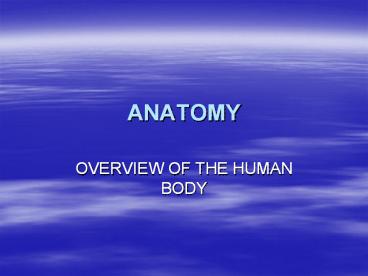ANATOMY - PowerPoint PPT Presentation
1 / 17
Title:
ANATOMY
Description:
ANATOMY OVERVIEW OF THE HUMAN BODY WHAT IS ..? ANATOMY is the study of the form and structure of the human body. PHYSIOLOGY is the study of the function or ... – PowerPoint PPT presentation
Number of Views:86
Avg rating:3.0/5.0
Title: ANATOMY
1
ANATOMY
- OVERVIEW OF THE HUMAN BODY
2
WHAT IS ..?
- ANATOMY is the study of the form and structure of
the human body. - PHYSIOLOGY is the study of the function or how
the body works.
3
BASIC SUBSTANCE OF LIFE
- Protoplasm makes up all living matter.
- Protoplasm contains carbon, oxygen, hydrogen,
nitrogen and other minerals.
4
CELLS
- Cells are the basic units or building blocks of
all living things. - Cells are made up of protoplasm.
- Cells carry on all functions of life.
5
CELLS
- Cells use food and oxygen eliminate waste, adapt
to environment and reproduce. - Cells may be different size and shapes.
6
Cells
- Some groups of cells may be highly specialized
e.g. nerve cells are quick to be respond to
stimuli, red blood cells carry oxygen. - Some specialized cells lose some function,
certain nerve cells do not reproduce. - An interdependency exists among cells to carry on
total life activities.
7
PARTS OF CELLS
- Cell membrane outer covering of cell
- Cytoplasm main substance of the cell, it is
liquid. - Nucleus brain of the cell.
- The nucleus contains the chromatin network and
nucleolus.
8
PARTS OF CELLS
- The nucleolus is one or more tiny parts within
the nucleus. - The chromatin network is made up of chromosomes
which contain the heredity genes, known as DNA.
9
TISSUES
- Cells group together by their shape, size,
structure, and function, and are called tissues. - This specialized grouping of cells make four
different types of tissues.
Skin structure
10
TYPES OF TISSUE
- Epithelial tissue covers surfaces and lines body
cavities, also forms glands. - Connective tissue holds parts of the body
together. It may be hard as in bone, or soft as
in vascular tissue (Blood vessels) - Both types repair easily.
11
TISSUE TYPES
- Nerve tissue conducts nerve impulses, and reacts
to stimuli. - Some nerve tissue does not repair, all is slow
and uncertain.
12
TISSUE TYPES
- Muscle tissue produces power by contractions
There are three types of muscle tissue. - Cardiac, located in the heart
- Skeletal muscles, also called voluntary
- Smooth muscles, called involuntary such as
digestive tract and kidney. - Repairs with difficulty resulting in scar tissue.
13
ORGANS
- Tissues which form together and perform special
functions are called organs. - Example Stomach and the skin which contain
epithelial, connective, muscle and nervous tissue.
14
Systems
- A group of organs working together to perform a
specific function are called systems. - The digestive system is made up of several
organs mouth, stomach, intestines. - The circulatory system contains the heart, blood
vessels.
15
REVIEW
16
Vocabulary words
- Cyt means cells
- ology- means study of
- Cytology means study of cells
- ologist means specialist
- Cytologist is a specialist who studies cells
17
Vocabulary
- Hist means tissue
- histology

